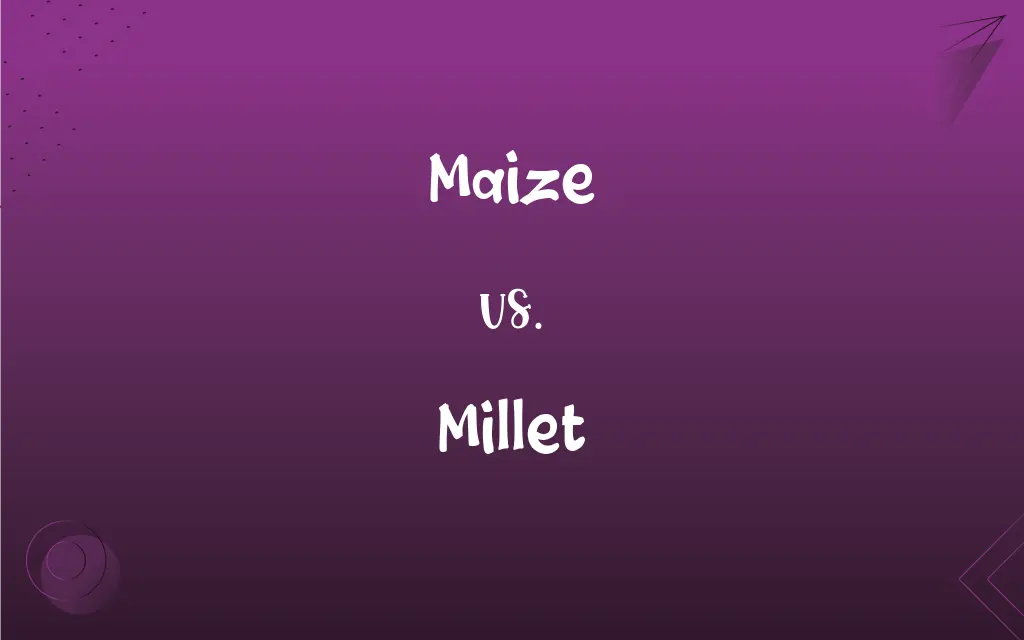Maize vs. Millet: What's the Difference?
Edited by Aimie Carlson || By Janet White || Published on December 5, 2023
Maize is a large grain plant domesticated by indigenous peoples in southern Mexico, while millet refers to small-seeded grasses widely grown as cereal crops or grains for fodder and human food.

Key Differences
Maize, also known as corn, originated in southern Mexico and has been a staple in American diets for centuries. Millet, on the other hand, encompasses various small-seeded grasses and originated in Africa and Asia, serving as a staple grain for millennia.
Maize thrives in warmer climates and requires more water and fertile soil compared to millet. Millet is highly adaptable, growing in harsh environments and poor soils where maize would not survive, making it crucial for subsistence farming in arid regions.
Maize is rich in carbohydrates and provides essential nutrients like vitamin B, magnesium, and phosphorus. Millet is a nutrient powerhouse, offering high levels of protein, dietary fiber, B vitamins, calcium, iron, potassium, zinc, and essential amino acids.
Maize is used in various forms like cornmeal, sweet corn, and popcorn. It's a key ingredient in dishes like tortillas, polenta, and cornbread. Millet is versatile in cooking, used in porridges, breads, cakes, and traditional dishes in Asian and African cuisines.
Maize holds significant economic value, especially in the Americas, and is a symbol of cultural heritage in many indigenous societies. Millet, while less prominent in global markets, is culturally important in parts of Africa and Asia, symbolizing sustenance and tradition.
ADVERTISEMENT
Comparison Chart
Origin
Domesticated in southern Mexico
Originated in Africa and Asia
Cultivation Needs
Requires more water and fertile soil
Grows in harsh, arid conditions
Nutritional Content
High in carbohydrates and vitamins
Rich in protein and dietary fiber
Culinary Uses
Used in tortillas, cornbread, etc.
Utilized in porridges, breads, etc.
Cultural Significance
Symbol of heritage in the Americas
Important in African, Asian cultures
ADVERTISEMENT
Maize and Millet Definitions
Maize
Maize, a staple food in many countries, is known for its versatility in various cuisines.
Maize is essential in Mexican cuisine, especially for making tortillas.
Millet
Millet refers to various small-seeded grasses widely cultivated as grains.
Millet is a crucial crop in arid regions.
Maize
Maize is increasingly used for biofuel production, particularly ethanol.
Maize cultivation for ethanol has sparked debates about food vs fuel.
Millet
It is known for its high nutritional value, including protein and dietary fiber.
Millet porridge is a nutritious breakfast option.
Maize
It is a major source of livestock feed globally.
The farm dedicated a large acreage to growing maize for feed.
Millet
Millet is celebrated for its drought resistance, thriving in harsh conditions.
Farmers rely on millet in regions with low rainfall.
Maize
Maize holds cultural significance in many indigenous societies.
Maize is revered in many Native American myths.
Millet
Millet serves as a gluten-free grain alternative.
Millet bread is a popular choice for those avoiding gluten.
Maize
Maize is a cereal grain first domesticated by indigenous peoples in southern Mexico.
The fields were golden with ripe maize.
Millet
It is a traditional ingredient in many African and Asian cuisines.
Millet is used in traditional African flatbreads.
Maize
See corn1.
Millet
Any of various annual grasses with small grains that are harvested for food, livestock feed, and birdseed, especially proso millet.
Maize
A light yellow to moderate orange yellow.
Millet
The grains of any of these plants.
Maize
Corn; a type of grain of the species Zea mays.
Maize
A large species of American grass of the genus Zea (Zea Mays), widely cultivated as a forage and food plant; Indian corn, commonly called corn. Also, its seed, growing on cobs, and used as food for men and animals.
Maize
Tall annual cereal grass bearing kernels on large ears: widely cultivated in America in many varieties; the principal cereal in Mexico and Central and South America since pre-Columbian times
Maize
A strong yellow color
FAQs
Where does maize grow best?
Maize grows best in warm climates with good soil and sufficient water.
Can maize be used for animal feed?
Yes, maize is a major source of animal feed globally.
What is millet?
Millet refers to various small-seeded grasses cultivated as cereal crops.
What are the nutritional benefits of maize?
Maize is rich in carbohydrates, vitamins, and essential minerals.
Is millet gluten-free?
Yes, millet is a gluten-free grain, suitable for those with gluten intolerance.
What are the common uses of maize in cooking?
Maize is used in cornbread, tortillas, popcorn, and more.
Is millet drought-resistant?
Yes, millet is highly drought-resistant, making it suitable for arid regions.
What is the cultural importance of millet?
Millet holds cultural importance in parts of Africa and Asia.
What is maize?
Maize, also known as corn, is a large cereal grain originally from Mexico.
How is millet beneficial for farmers in harsh climates?
Millet's adaptability to harsh climates makes it a reliable crop for such farmers.
How nutritious is millet?
Millet is high in protein, fiber, vitamins, and minerals.
Is maize used in biofuel production?
Yes, maize is used to produce ethanol, a type of biofuel.
How has maize cultivation evolved over time?
Maize cultivation has evolved with advancements in agricultural techniques and genetic modification.
How does millet contribute to food security?
Millet's resilience contributes to food security in regions prone to drought.
What are the different varieties of millet?
Common varieties of millet include pearl, foxtail, and finger millet.
What role does millet play in sustainable agriculture?
Millet supports sustainable agriculture due to its low water requirement and soil adaptability.
What are the environmental impacts of growing maize?
Maize cultivation can impact the environment through water usage and pesticide use.
How is millet used in cooking?
Millet is used in porridges, breads, and traditional dishes.
Does maize have cultural significance?
Yes, maize is culturally significant, especially in indigenous American cultures.
Are there different types of maize?
Yes, there are various types of maize, including sweet corn and field corn.
About Author
Written by
Janet WhiteJanet White has been an esteemed writer and blogger for Difference Wiki. Holding a Master's degree in Science and Medical Journalism from the prestigious Boston University, she has consistently demonstrated her expertise and passion for her field. When she's not immersed in her work, Janet relishes her time exercising, delving into a good book, and cherishing moments with friends and family.
Edited by
Aimie CarlsonAimie Carlson, holding a master's degree in English literature, is a fervent English language enthusiast. She lends her writing talents to Difference Wiki, a prominent website that specializes in comparisons, offering readers insightful analyses that both captivate and inform.







































































